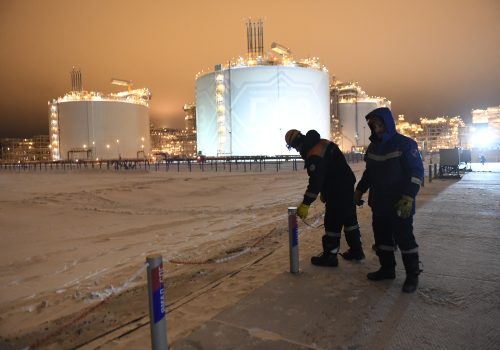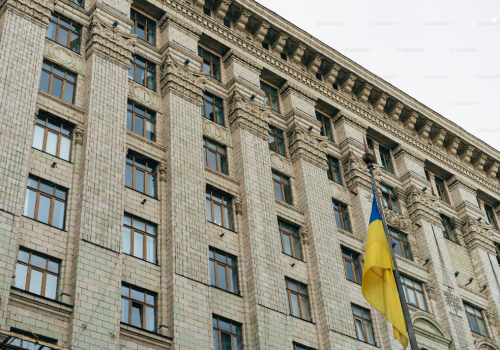Despite Russia’s ongoing war in Ukraine, Russian gas continues to transit Ukraine on its way to European buyers. By and large, both sides continue to adhere to the 2019 EU-brokered gas transit agreement. Under that agreement, Gazprom is obliged to ship a minimum volume of gas—65 billion cubic meters (bcm) in the first year and 40 bcm in subsequent years—under ship-or-pay conditions. But there has been much speculation about what happens to transit when the 2019 agreement expires at the end of December 2024.
STAY CONNECTED
Sign up for PowerPlay, the Atlantic Council’s bimonthly newsletter keeping you up to date on all facets of the energy transition.
Ukraine’s gas transmission system has traditionally played a major role in delivery of Russian gas to Europe. As late as 2019, transit volume was about 90 bcm, accounting for one half of Russia’s total gas exports to Europe. After Moscow’s full-scale invasion, the continuation of Russian gas transit through Ukraine provided EU member states energy security while also buying them time to arrange for alternative natural gas supplies. And by 2023, the transit volume had fallen to less than 13 bcm, with most of the gas being delivered to Austria, Italy, Hungary, and Slovakia. Other major consumers, including Germany, Poland, and the Czech Republic, have managed to end their dependence on Russian pipeline gas and Russian gas in general, although Russian LNG exports to Europe have continued to rise. But since 2022 the United States has emerged as a main LNG supplier to Europe, accounting for nearly half of total EU LNG imports in 2023 and helping to blunt Europe’s need for Russian LNG.
Of the countries most likely to be directly affected by the expiration of the 2019 agreement, Slovakia and Hungary have been the most vocal in calling for the continuation of Ukraine transit. Italy already has been able to largely replace Ukraine transit gas with LNG and pipeline gas from other sources, including Azerbaijan, and has been silent on the future transit issue. Austria presents a mixed picture. Some Austrian politicians have expressed concerns over its growing dependence on Russian gas, while others have signified their reluctance to break existing supply contracts.
For its part, the EU has expressed the view that there is no need to extend the current transit agreement, although it has not commented on the prospects for transit in the absence of an agreement. This could take the form of capacity bookings by European traders who would take delivery of Russian gas at Ukraine’s eastern border. This possibility has been discussed with little interest for many years until recently, presumably because European traders were not willing to take the attendant risk.
Meanwhile, the view from Kyiv is muddled at best. The minister of energy has completely ruled out future transit, but the prime minister has nixed an extension of the current agreement, while suggesting that transit still might continue under the right circumstances. The head of the Ukrainian gas transit company has similarly expressed willingness to continue transit at least through 2027, the proposed target date for EU countries to phase out imports of Russian fossil fuels.
The arguments in favor of Ukraine continuing to offer transit are weak, premised on the revenue Ukraine earns from transit and concerns over the availability and price of replacement gas. The first concern is overblown. Although Ukraine currently collects about $800 million per year from transit, that does not account for the costs of operating the system. Given the (EU-style) tariff methodology employed by Ukraine, the actual financial benefit is much less, and in the context of Ukraine’s economy, relatively insignificant at 0.46 percent of GDP.
Concerns about replacing Ukraine transit gas are equally overblown. Countries now dependent on Ukraine transit can easily source replacement gas, particularly LNG. Increases in US and Canadian LNG production in 2025-2026 alone would more than replace Russian gas currently being transited via Ukraine.
Meanwhile, the EU has added around 50 bcm of LNG regasification capacity since 2022. Further capacity expected to come online by the end of 2024 will result in total capacity of about 235 bcm, able to meet over 55 percent of European annual gas demand based on the gas consumption average of the last five years.
The argument that the end of transit would lead to much higher gas prices in Europe is likewise questionable. The EU gas market has currently stabilized and returned to its pre-war price range, and Ukrainian transit accounts for only 4 percent of total European demand.
So why the pressure to continue transit once the agreement lapses if Ukraine transit gas can economically be replaced with gas that doesn’t originate in Russia? In the case of Slovakia, and to a lesser extent Austria, purely financial considerations may be at work. The end of Ukraine transit could hit Slovakia hard, since most of the Ukraine transit gas also transits Slovakia through the Eustream pipeline system. However, Eustream has a ship-or-pay contract with Gazprom extending to 2028, obligating payment by Gazprom even in the absence of transit (although force majeure might excuse non-performance). The economic damage to Austria is likely smaller, since it also earns revenue from non-Russian gas transiting its Baumgarten hub.
However, Russia’s continued aggression and the war’s potential to escalate into a NATO-Russia or EU-Russia conflict underline the need for European unity and solidarity, particularly in reducing the export revenues of the aggressor. Billions of dollars in gas revenues from NATO and EU members should not be used to fuel Russia’s military capabilities. In fact, the EU is now considering a complete ban on Russian LNG imports.
Moreover, the continued reliance on Russian pipeline gas gives Russia undue political leverage and creates disunity among EU member states, weakening the West’s overall response to Russian aggression. Ending transit via Ukraine after 2024 would enhance the region’s energy security and diminish Russia’s export income with minimal disruption in gas supplies.
The Ukrainian government may face political pressure from some EU member states to maintain gas transit, with or without an agreement. To counter this pressure, the United States should: (1) discourage its EU allies from continuing to import Russian gas via Ukraine and (2) urge Ukraine to resist this pressure, while also encouraging the EU to support Ukraine in its stance.
Sergiy Makogon is the former CEO of GasTSO of Ukraine (2019-2022).
Daniel D. Stein is a former senior advisor with the Bureau of Energy Resources at the US Department of State.
Related content
Learn more about the Global Energy Center

The Global Energy Center develops and promotes pragmatic and nonpartisan policy solutions designed to advance global energy security, enhance economic opportunity, and accelerate pathways to net-zero emissions.
Image: A 2019 agreement for Russian gas to transit Ukraine will expire at the end of 2024. REUTERS/Gleb Garanich




